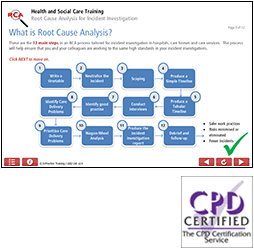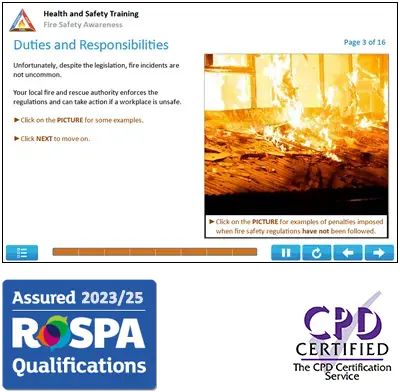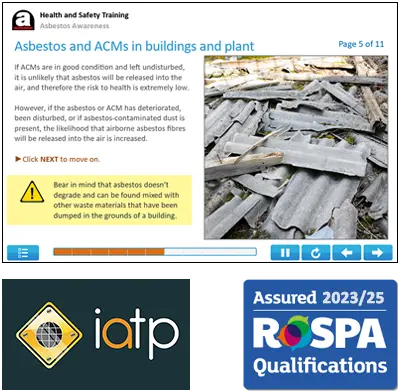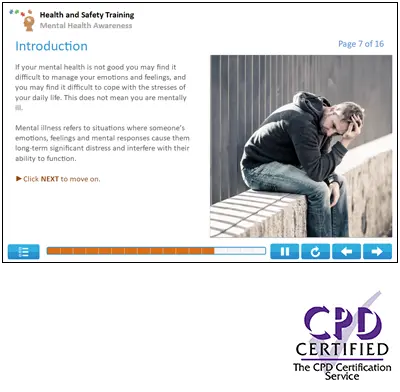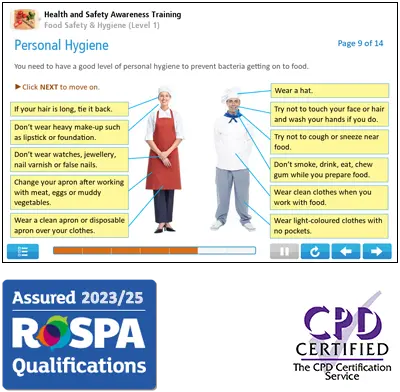Discounts Available For Bulk Purchases
| No. of licences per course |
% saving |
|---|---|
| 1 - 9 | - |
| 10 - 19 | 10% |
| 20 - 49 | 20% |
| 50 - 99 | 25% |
| 100 - 149 | 30% |
| 150 - 999 | 35% |

I2Comply have teamed up with InPractice, a medico-legal consultancy providing training on law and ethics to the NHS, private healthcare providers, professional associations and pharmaceutical companies.
Find out more
Root Cause Analysis for Incident Investigation Course (Level 2)
£90.00
- Certified by CPD
- Audio voiceover
- Approximate course duration 4 hours
- Downloadable certificate on completion
- 100% online training
This Root Cause Analysis for Incident Investigation online training provides a structured approach to incident investigation. It covers gathering and organising the information, through a detailed analysis of the issues and evidence, to the production of the formal report. The training follows a proven Root Cause Analysis (RCA) methodology.
This course takes approximately 4 hours to complete. However, you can complete the training in multiple sessions and take as long as you need to complete the course.
Which Root Cause Analysis training course should I take?
Level 1 – Is an introductory course that is suitable for people that will be involved in investigations. Staff are able to understand the process and know what to expect during the actual investigation. It can also be used by investigators before further face-to-face training.
Level 2 – Is a comprehensive course that is designed for investigators. It covers gathering and organising the information, through a detailed analysis of the issues and evidence, to the production of the formal report. Please note: the level 2 course covers all the material in Root Cause Analysis for Incident Investigation (Level 1) course.
What is Root Cause Analysis?
Root Cause Analysis (RCA) is a problem solving methodology that identifies the root cause of an incident. It explores all of the possible factors associated with that incident. The process addresses four questions. What happened? How did it happen? Why did it happen? What can be done to prevent it from happening again?
RCA is not about assigning blame or focusing on individual errors. It is about the systems and controls in place that allowed the incident to happen.
Who is the Root Cause Analysis for Incident Investigation (Level 2) Course for?
This Level 2 course is a comprehensive training package for investigators.
After completing the course you will be able to describe:
- The purpose of RCA in an incident investigation
- The underlying principles that guide RCA in incident investigation
- 12 key steps when applying RCA
- How information is gathered and organised in the investigation folder
- The purpose of a wagon-wheel analysis and explain how a wagon-wheel is produced
- How RCA can produce recommendations that are both actionable and measurable
- The essential elements of an incident investigation report and explain how it is produced
- How the investigation outcomes are communicated to participants
When do I get my Root Cause Analysis certificate?

When you have passed the course you can download and print your certificate straight away.
All of our courses conform to the Continuing Professional Development (CPD) guidelines and have been accredited by the CPD Certification Service. Your certificate will include the CPD logo and, therefore, you can use it to provide evidence for compliance.

How long is this Root Cause Analysis certificate valid for?
Your Root Cause Analysis for Incident Investigation (Level 2) course certificate does not expire.
Example Screens from the Root Cause Analysis course
You can click below to see example screens from our Root Cause Analysis for Incident Investigation (Level 2) online course. Our training course materials are presented in a concise and simple-to-follow manner, which ensure accurate understanding and long-term retention.
(Click on the example screens below to view)
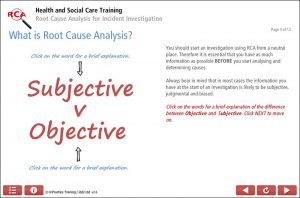

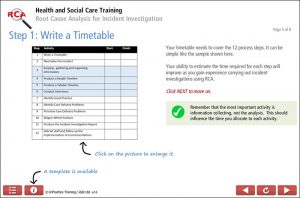
The online course contains the following 17 topics:
1 – What is Root Cause Analysis?
The first topic outlines the purpose of an RCA investigation. It explains the focus on improvement and avoidance of blame. You will also learn about the twelve steps in an RCA investigation.
2 – Step 1: Write a Timetable
The second topic explains why you need a timetable and how to produce one. Then you will learn about why information gathering is more important than information analysis.
3 – Step 2: Neutralise the Incident
The third topic explains why it is important that you have a neutral statement about the incident. You will learn how to reword a statement to remove all subjective terms.
4 – Step 3a: Scoping – Introduction
The fourth topic describes the purpose of scoping and outlines three scoping activities.
5 – Step 3b: Scoping – The 5 Hypotheses
This topic describes the activity called ‘5 hypotheses’. You will learn how to produce 5 hypotheses about the incident.
6 – Step 3c: Scoping – 4 Ps (Paper, People, Parts, Place)
This topic is about the 4 Ps of Root Cause Analysis. You will learn about how the 5 hypotheses of the previous topic generate the 4 Ps.
7 – Step 3d: Scoping – Index the Information
This topic describes how to organise the information identified in the 4 Ps activity. You will learn how to ensure cooperation with information requests. You will also learn about when to move on to the next step in your investigation.
8 – Step 4: Produce a Simple Timeline
This topic explains how to identify relevant events and then how to put them in a simple timeline.
9 – Step 5: Produce a Tabular Timeline
This topic describes how to create a tabular timeline, You will learn how to populate this timeline with events, dates and times. You will also learn how to deal with missing information.
10 – Step 6: Conduct Interviews
This topic explains how to select people for interview. Then you will learn about how to question people in an interview. The topic also explains how to interview witnesses without alienating them.
11 – Step 7: Identifying Good Practice
This topic is about how and why to add instances of good practice to the tabular timeline.
12 – Step 8: Identifying Care Delivery Problems
This topic explains how to add care delivery problems to the tabular timeline. Then you will learn how to write about these problems precisely.
13 – Step 9: Prioritise Service Delivery Problems
In this topic you will learn how to prioritise problems using the Nominal Group Technique.
14 – Step 10: Wagon-Wheel Analysis
In this topic you will learn about how and why to carry out a Wagon-Wheel analysis.
15 – Step 10: Wagon-Wheel Analysis – Identifying Root Causes
In this topic you will learn how to evaluate each contributory factor in the Wagon-Wheel analysis to determine whether or not it is a root cause.
16 – Step 11: Produce the Incident Investigation Report
This topic explains how to produce the Incident Investigation Report that is fit for purpose.
17 – Step 12: Debrief and Follow-up
The final topic explains why you need to give staff feedback and what should be included in the feedback.
Root cause analysis for incident investigation (Level 2) online course assessment
There is an assessment at the end of each topic and you can do each assessment as often as necessary.
When you have completed all the assessments then you have passed the course and can download a certificate of your achievement.
Root cause analysis for incident investigation (Level 2) online course reviews
It is always a good idea to check customers’ reviews before you commit to buying an online training course. Take a look at what our customers think about our Root Cause Analysis for Incident Investigation (Level 2) course here. This may help you decide whether this training course is what you are looking for.
Feedback is extremely important to us. If you can leave a review we would really appreciate it.
Other online courses
We offer a wide selection of online training courses for businesses and individuals who are seeking relevant training and certification. We help them to adhere to their legal duties and keep people safe. You can explore our online training courses in categories including health and safety, regulatory compliance, food hygiene and fire safety or see a full list of courses here.
Are you ready to get started?
When you are ready to purchase our Root Cause Analysis for Incident Investigation (Level 2) online course, simply click Add to Basket at the top right or bottom right of the page and proceed to checkout.
Once your purchase is complete, we will email your login details along with instructions on how to access the course. There is no set time in which you need to complete the course after purchase. You can buy the course now and start studying at a time that suits you.
Still have a questions?
If you have any questions, we invite you to visit our Help & Support page, where you will find answers to commonly asked questions regarding accounts, training licences, certificates, payments and more.
£90.00
Discounts Available For Bulk Purchases
| No. of licences per course |
% saving |
|---|---|
| 1 - 9 | - |
| 10 - 19 | 10% |
| 20 - 49 | 20% |
| 50 - 99 | 25% |
| 100 - 149 | 30% |
| 150 - 999 | 35% |
